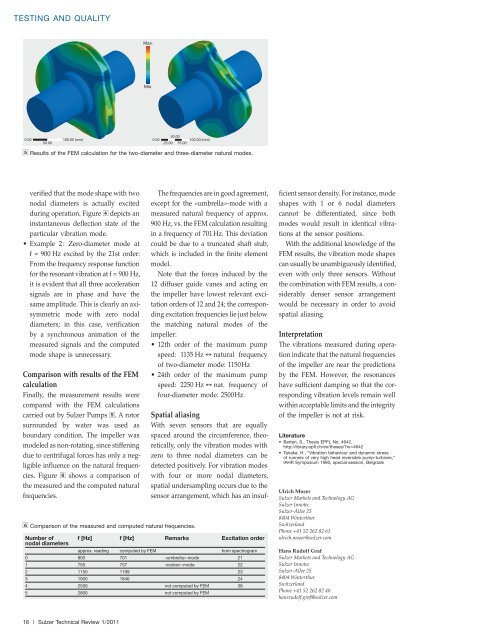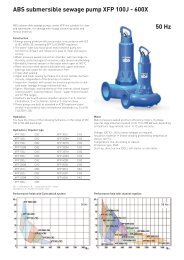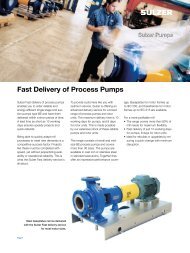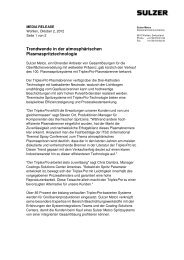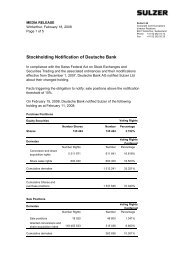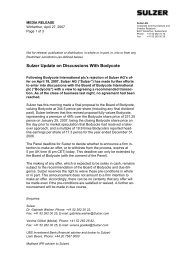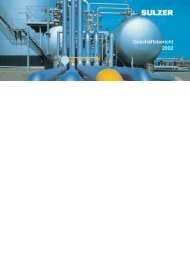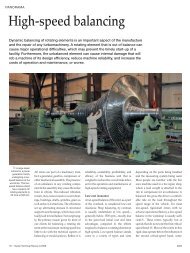Testing and quality
Testing and quality
Testing and quality
You also want an ePaper? Increase the reach of your titles
YUMPU automatically turns print PDFs into web optimized ePapers that Google loves.
TESTING AND QUALITY<br />
0.00 100.00 (mm)<br />
50.00<br />
5 Results of the FEM calculation for the two-diameter <strong>and</strong> three-diameter natural modes.<br />
verified that the mode shape with two<br />
nodal diameters is actually excited<br />
during operation. Figure 4 depicts an<br />
instantaneous deflection state of the<br />
particular vibration mode.<br />
• Example 2 : Zero-diameter mode at<br />
f=900 Hz excited by the 21st order:<br />
From the frequency response function<br />
for the resonant vibration at f = 900 Hz,<br />
it is evident that all three acceleration<br />
signals are in phase <strong>and</strong> have the<br />
same amplitude. This is clearly an axisymmetric<br />
mode with zero nodal<br />
diameters; in this case, verification<br />
by a synchronous animation of the<br />
measured signals <strong>and</strong> the computed<br />
mode shape is unnecessary.<br />
Comparison with results of the FEM<br />
calculation<br />
Finally, the measurement results were<br />
compared with the FEM calculations<br />
carried out by Sulzer Pumps 5. A rotor<br />
surrounded by water was used as<br />
boundary condition. The impeller was<br />
modeled as non-rotating, since stiffening<br />
due to centrifugal forces has only a negligible<br />
influence on the natural frequencies.<br />
Figure 6 shows a comparison of<br />
the measured <strong>and</strong> the computed natural<br />
frequencies.<br />
6 Comparison of the measured <strong>and</strong> computed natural frequencies.<br />
16 | Sulzer Technical Review 1/2011<br />
The frequencies are in good agreement,<br />
except for the «umbrella»-mode with a<br />
measured natural frequency of approx.<br />
900 Hz, vs. the FEM calculation resulting<br />
in a frequency of 701 Hz. This deviation<br />
could be due to a truncated shaft stub,<br />
which is included in the finite element<br />
model.<br />
Note that the forces induced by the<br />
12 diffuser guide vanes <strong>and</strong> acting on<br />
the impeller have lowest relevant excitation<br />
orders of 12 <strong>and</strong> 24; the corresponding<br />
excitation frequencies lie just below<br />
the matching natural modes of the<br />
impeller:<br />
• 12th order of the maximum pump<br />
speed: 1135 Hz ↔ natural frequency<br />
of two-diameter mode: 1150Hz<br />
• 24th order of the maximum pump<br />
speed: 2250 Hz ↔ nat. frequency of<br />
four-diameter mode: 2500Hz.<br />
Spatial aliasing<br />
With seven sensors that are equally<br />
spaced around the circumference, theoretically,<br />
only the vibration modes with<br />
zero to three nodal diameters can be<br />
detected positively. For vibration modes<br />
with four or more nodal diameters,<br />
spatial undersampling occurs due to the<br />
sensor arrangement, which has an insuf-<br />
Number of f [Hz] f [Hz] Remarks Excitation order<br />
nodal diameters<br />
approx. reading computed by FEM from spectrogram<br />
0 900 701 «umbrella»-mode 21<br />
1 750 757 «rocker»-mode 22<br />
2 1150 1199 23<br />
3 1900 1846 24<br />
4 2500 not computed by FEM 38<br />
Max.<br />
5 2800 not computed by FEM<br />
Min.<br />
50.00<br />
0.00 100.00 (mm)<br />
25.00 75.00<br />
ficient sensor density. For instance, mode<br />
shapes with 1 or 6 nodal diameters<br />
cannot be differentiated, since both<br />
modes would result in identical vibrations<br />
at the sensor positions.<br />
With the additional knowledge of the<br />
FEM results, the vibration mode shapes<br />
can usually be unambiguously identified,<br />
even with only three sensors. Without<br />
the combination with FEM results, a considerably<br />
denser sensor arrangement<br />
would be necessary in order to avoid<br />
spatial aliasing.<br />
Interpretation<br />
The vibrations measured during operation<br />
indicate that the natural frequencies<br />
of the impeller are near the predictions<br />
by the FEM. However, the resonances<br />
have sufficient damping so that the corresponding<br />
vibration levels remain well<br />
within acceptable limits <strong>and</strong> the integrity<br />
of the impeller is not at risk.<br />
Literature<br />
• Berten, S., Thesis EPFL No. 4642,<br />
http://library.epfl.ch/en/theses/?nr=4642<br />
• Tanaka, H., “Vibration behaviour <strong>and</strong> dynamic stress<br />
of runners of very high head reversible pump-turbines,”<br />
IAHR Symposium 1990, special session, Belgrade<br />
Ulrich Moser<br />
Sulzer Markets <strong>and</strong> Technology AG<br />
Sulzer Innotec<br />
Sulzer-Allee 25<br />
8404 Winterthur<br />
Switzerl<strong>and</strong><br />
Phone +41 52 262 82 61<br />
ulrich.moser@sulzer.com<br />
Hans Rudolf Graf<br />
Sulzer Markets <strong>and</strong> Technology AG<br />
Sulzer Innotec<br />
Sulzer-Allee 25<br />
8404 Winterthur<br />
Switzerl<strong>and</strong><br />
Phone +41 52 262 82 40<br />
hansrudolf.graf@sulzer.com


